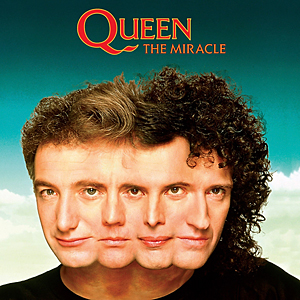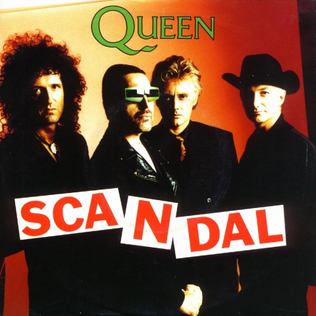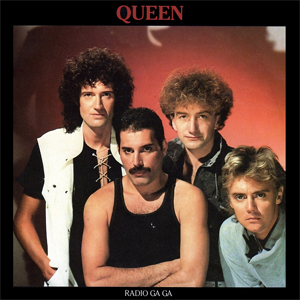
"Bohemian Rhapsody" is a song by the British rock band Queen, released as the lead single from their fourth album, A Night at the Opera (1975). Written by lead singer Freddie Mercury, the song is a six-minute suite, notable for its lack of a refraining chorus and consisting of several sections: an intro, a ballad segment, an operatic passage, a hard rock part and a reflective coda. It is one of the few progressive rock songs of the 1970s to achieve widespread commercial success and appeal to a mainstream audience.

"Under Pressure" is a song by the British rock band Queen and singer David Bowie. Originally released as a single in October 1981, it was later included on Queen's 1982 album Hot Space. The song reached number one on the UK Singles Chart, becoming Queen's second number-one hit in their home country and Bowie's third, and also charted in the top 10 in more than 10 countries around the world.

"Crazy Little Thing Called Love" is a song by the British rock band Queen. Written by Freddie Mercury in 1979, the track is included on their 1980 album The Game, and also appears on the band's compilation album Greatest Hits in 1981. The song peaked at number two in the UK Singles Chart in 1979, becoming the group's first number-one single on the Billboard Hot 100 in the US in 1980, remaining there for four consecutive weeks. It topped the Australian ARIA Charts for seven weeks. It was the band's final single release of the 1970s.

Innuendo is the fourteenth studio album by the British rock band Queen, released on 4 February 1991 by Parlophone in the United Kingdom and it is the band's first studio album to be released by Hollywood Records in the United States. Produced by David Richards and the band, it was the band's last album to be released in lead singer Freddie Mercury's lifetime, and their most recent one to be composed of entirely new material, save for The Cosmos Rocks by the Queen + Paul Rodgers collaboration. It reached the No. 1 spot on the UK album charts for two weeks, and also peaked at No. 1 in Italy, the Netherlands, Germany, and Switzerland, staying at No. 1 for three weeks, four weeks, six weeks, and eight weeks, respectively. It was the first Queen album to go Gold in the US upon its release since The Works in 1984.

Made in Heaven is the fifteenth and final studio album by the British rock band Queen, released on 6 November 1995 by Parlophone Records in the United Kingdom and by Hollywood Records in the United States. It was the band's first and only album released solely under the name "Queen" after the death of lead singer Freddie Mercury in 1991. Following Mercury's death, guitarist Brian May, drummer Roger Taylor, and bass guitarist John Deacon worked with vocal and piano parts that Mercury recorded before his death, adding new instrumentation to the recordings. Both stages of recording, before and after Mercury's death, were completed at the band's studio in Montreux, Switzerland. The album debuted at number 1 in the UK, where it went quadruple platinum selling 1.2 million copies. 500,000 copies were shipped in the United States.

The Miracle is the thirteenth studio album by the British rock band Queen, released on 22 May 1989 by Parlophone Records and Capitol Records in both the United Kingdom and the U.S. respectively, where it was the band's only studio album to be released on latter label. The album was recorded as the band recovered from Brian May's marital problems and Freddie Mercury's HIV diagnosis in 1987. Recording started in January 1988 and lasted for an entire year. The album was originally going to be called The Invisible Men, but three weeks before the release, according to Roger Taylor, they changed the name to The Miracle. It was also the last Queen album with a photo of the band on the front cover.

"I Was Born to Love You" is a 1985 song by Freddie Mercury that was released as a single from his first solo album, Mr. Bad Guy. After Mercury's death, Queen re-worked this song for their album Made in Heaven in 1995, by having the other members play their instrumental parts over the original track, transforming the song from disco to rock. The Queen version from the Made in Heaven album also includes snippets of Mercury's ad-lib vocals taken from "A Kind of Magic" and from "Living on My Own".

"Killer Queen" is a song by the British rock band Queen. It was written by lead singer Freddie Mercury and recorded for their third album Sheer Heart Attack in 1974. It reached number two in the UK Singles Chart and became their first US hit, reaching number twelve on the Billboard Hot 100. The song is about a high-class call girl and has been characterised as "Mercury's piano-led paean to a Moët-quaffing courtesan".

"I Want to Break Free" is a song by the British rock band Queen, written by their bassist John Deacon. It appears on the album The Works (1984), and was released in three versions: album, single and extended. The track became a staple of the bands during their 1984–85 Works Tour and their 1986 Magic Tour.

"Innuendo" is a song by the British rock band Queen. Written by Freddie Mercury and Roger Taylor but credited to Queen, it is the opening track on the album of the same name (1991), and was released as the first single from the album. The single debuted at number one on the UK Singles Chart in January 1991, the band's first number-one hit since "Under Pressure" in 1981, and additionally reached the top ten in ten other countries. It is included on the band's second compilation album Greatest Hits II. It was described as "the band's first complex work released after the 1970s".

"Breakthru" is a song by the British rock band Queen. Written by Freddie Mercury and Roger Taylor but credited to Queen, it was released in June 1989 from the album The Miracle. The single reached number seven in the UK, and peaked at number 6 in the Netherlands and Ireland, but failed to chart in the US. The song is notable for its video where the group is performing the song on an open platform of a fast-moving steam train.

"Somebody to Love" is a song by the British rock band Queen, written by the lead singer/pianist Freddie Mercury. It debuted on the band's 1976 album A Day at the Races and also appears on their 1981 compilation album Greatest Hits.

"Too Much Love Will Kill You" is a song written by British guitarist Brian May of Queen, Frank Musker and Elizabeth Lamers. The song reflected the breakdown of May's first marriage and attraction to his future wife, Anita Dobson. It was first recorded by Queen around 1988 or before, and was intended to be on the band's The Miracle album in 1989, but did not make the cut due to legal disputes following the band's decision that all songs on the album would be written by the group as opposed to individuals.

"Scandal" is a song by the British rock band Queen. It was released as the fourth single from their 1989 album The Miracle and peaked at #25 in the UK. The single was released in the United States but failed to chart.

"The Invisible Man" is a song by the British rock band Queen, written by drummer Roger Taylor but credited to Queen. The song is sung mostly by Freddie Mercury, with vocal contributions from Taylor. The song was released in August 1989 as the third single from the bands album The Miracle. Taylor claims that he got the inspiration to create the song while reading a book, and the bassline instantly came to his imagination. The song title was inspired by the H. G. Wells novel of the same name.

"The Miracle" is the fifth and final single from Queen's 1989 studio album of the same name. It was composed by the entire band, though Freddie Mercury and John Deacon were the main writers. It was released as a single on 27 November 1989 and it was the band's final single release of the 1980s.

The Works is the eleventh studio album by the British rock band Queen. It was released on 27 February 1984 by EMI Records just shortly after recording for the album had been completed in the United Kingdom and it is the band's first studio album to be released by Capitol Records in the United States. After the synth-heavy Hot Space (1982), the album saw the re-emergence of Brian May and Roger Taylor's rock sound, while still incorporating the early 80s retro futuristic electronic music and New York funk scenes. Recorded at the Record Plant Studios in Los Angeles, California, and Musicland Studios in Munich, Germany, from August 1983 to January 1984, the album's title comes from a comment Taylor made as recording began – "Let's give them the works!".

"Made in Heaven" is the third single recorded by Freddie Mercury, and his fourth release as a solo artist. Originally featured in Mercury's first solo album, Mr. Bad Guy, the song was slightly modified and published as a 45 rpm single paired with "She Blows Hot and Cold", described on the record sleeve as 'A Brand New Track'. The single reached No. 57 on the UK Singles Chart.

"Radio Ga Ga" is a 1984 song performed and recorded by the British rock band Queen, written by their drummer Roger Taylor. It was released as a single with "I Go Crazy" by Brian May as the B-side. It was included on the album The Works and is also featured on the band's compilation albums Greatest Hits II and Classic Queen.

"Face It Alone" is a song by British rock band Queen. Written by Brian May, John Deacon, Roger Taylor and Freddie Mercury and produced by David Richards, Kris Fredriksson and Justin Shirley-Smith, recorded over thirty years prior to its eventual release, and originally thought "unsalvageable" by May and Taylor, it was released on 13 October 2022 as a single as part of promotion for The Miracle Collector’s Edition box set, which itself was released on 18 November 2022.



















